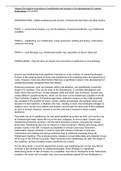Assess the relative importance of weathering and erosion in the development of coastal
landscapes. [20 marks]
INTRODUCTION – define weathering and erosion, introduce the fact there are other factors.
PARA 1 – erosional processes, e.g. the Sundarbans. Erosional landforms, e.g. Holderness
coastline.
PARA 2 – weathering, e.g. Holderness, mass movement, wetting and drying, carbonation,
rotational slumping.
PARA 3 – rock lithology, e.g. Holderness bolder clay, deposition at Spurn Head spit.
CONCLUSION – they do have an impact, but conclusion is partial due to rock lithology.
Erosion and weathering have significant importance in the creation of coastal landscapes.
Erosion is the wearing away of rocks and weathering is the breaking down and dissolving of
rocks. However, there are other factors that have a significant impact in the development of
coastal landscapes alongside these two factors.
Erosional processes, such as hydraulic action and abrasion, can significantly impact the
shape of a coastline. This can be seen at the Sundarbans, in southern Bangladesh and
India, which has lost 65 km2 of land between 2000 and 2009, due to erosion. Erosion can
create different coastal landforms, which can be seen on the Holderness coastline in North
East Yorkshire, England. At Flamborough head, extensive erosion on the chalk headland
has resulted in the creation of caves, arches, stacks and stumps. As hydraulic action and
abrasion hit the headland, it weakens the rock, creating a crack, this eventually enlarges to
create a cave. As the cave widens and erosion cuts through the other side of the headland,
an arch is formed. However, erosion is not the only factor involved in these coastal
landforms.
This leads me on to weathering. As sub-aerial weathering erodes an arch, such as the one
at Flamborough head, slowly the top of the arch collapses, to form a stack. Erosion and
weathering processes continue, until the stack becomes a stump, changing the coastal
landscape. Weathering also has an impact on mass movement. Wetting and drying, which
creates cracks in the cliff, increases susceptibility to erosion and mass movement.
Carbonation causes minerals in rocks to react with calcium carbonate in acid rain.
Carbonation and wetting and drying combined lead to rotational slumping along the
Holderness coastline. This is where erosion creates a curved slide plane and material moves
off the top of the Cliff due to gravity. Mass movement and weathering can alter the shape of
the coastline, as they increase erosion landforms as a result.
On the other hand, it could be argued that erosion and weathering are not the only factors
involved in the development of coastal landscapes. Rock lithology is a significant
determining factor of rate of erosion on a coastline. Over the 61 kilometres of the Holderness
coastline, the main rock is boulder clay, and unconsolidated glacial till from Bridlington to




